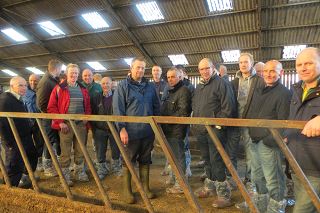The Forsyth family owns a large-scale livestock enterprise and recently hosted a group of Northern Irish dairy farmers on their 500-hectare, Broadwigg unit at Whithorn, where Dave Ellis, the herd manager has been in charge for three years.
Dave manages 1,310 cows which are housed year-round, the cows are carefully monitored to achieve a calving interval of 393 days. Rolling milk yield averages 10,500 litres. Age at first calving is two years and the cows produce for 3.4 lactations.
“At this scale, proper protocols must be in place at every level. Cow welfare is paramount so I make sure that protocols are followed. We have a good team spirit and retain staff, which is vital to the success of a large herd,” he told the visitors.
In a bid to reduce input costs, the business installed a slurry separator to produce recycled manure solids that now provides green bedding for the herd. “We did have some teething problems. Initially the recycled material was too wet and mastitis levels shot up. It turned out that a new motor was required to get the dry matter to 35%. Since this has been achieved we are now returning to mastitis levels of 25 cases per 100 cows. Green bedding looks set to offer a six figure saving to this herd and we’re now confident that it is the right bedding choice for the stock.”
Samuel Steele, who manages a 500-cow herd in Rowreagh, Co. Down, said seeing a herd double the size of his was inspiring. “The passion for improvement and growth whilst retaining attention to detail is clear to see in both the businesses we visited. I’m very impressed to see how large workforces are all pulling together in the right direction.”
The group also visited a second farm where Mark Callandar milks 1,150 Ayrshire cross cows on 760 hectares of grassland. A satellite unit nearby is milking an additional 200 head and rearing the heifers.
The main herd is permanently housed, fed on a silage-based diet, with readily available distillery by-products, cereals and inclusion of a high energy and protein blend. “Both the cows and staff prefer three times a day milking. It works very well and the cows average 9,500 litres, calving all year round,” Mark said.
“Cow welfare is our top priority. At herd level we are always striving to improve. Currently cow fertility, lameness and management of dry and newly calved cows are targets that are closely monitored on a weekly basis to assess progress.”
Energy efficiency is also important, with the farm using electricity generated from two 100 KW wind turbines to pump slurry into a lagoon at the satellite farm from where it can be spread more easily, he said.
The group of 50 dairy farmers from Northern Ireland took part in a two-day educational tour incorporating a visit to two units, each milking over 1,000 cows in southwest Scotland. The group also visited the AgriScot show as part of the excursion, which was hosted by Norbrook.
